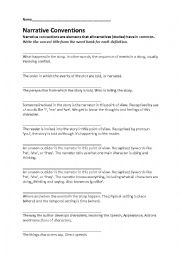
|
Narrative Conventions Worksheet
Students use their knowledge of narrative conventions to match words from the word bank to the definitions.
Answers: Narrative Conventions
Plot
What happens in the story. In other words, the sequence of events in a story, usually involving conflict.
Structure
The order in which the events of the plot are told, or narrated.
Point of View
The perspective from which the story is told. Who is telling the story.
First Person point of view
Someone involved in the story is the narrator in this point of view. Recognised by use of words like ‘I’, ‘me’ and ‘we’. We get to know the thoughts and feelings of this character.
Second Person point of view
The reader is invited into the story in this point of view. Recognised by pronoun ‘you’, the story is told as though it’s happening to the reader.
Third Person Limited point of view
An unseen outsider is the narrator in this point of view. Recognised by words like ‘he’, ‘she’, or ‘they’. The narrator tells us what one main character is doing and thinking.
Third Person Omniscient point of view
An unseen outsider is the narrator in this point of view. Recognised by words like ‘he’, ‘she’, or ‘they’. The narrator knows everything, including what all characters are doing, thinking and saying. Also known as ‘godlike’.
Setting
Where and when the events in the story happen. The physical setting is place (where) and the temporal setting is time (when).
Characterisation
The way the author develops characters, involving the Speech, Appearance, Actions and Interactions of characters.
Dialogue
The things characters say. Direct speech.
Style
The way in which a story is written, involving the language choices, tone created, amount of description etc. Writers have unique styles.
Motifs
Central themes or topics that recur throughout novels, forming a pattern.
Metaphors
Used to describe someone or something as if it were something else.
Themes
Main ideas or messages contained in a story. What the author wants the reader to learn about life and people from reading the story.
Symbols
Something that represents something else. Objects used to represent ideas or concepts.
Context
Circumstances under which a text is written, read and set. There are three types; reader context, author context and novel context.
Genre
Type or category of writing. Some examples include romance, science fiction, horror and fantasy. Genres often share themes.
Orientation
The beginning of a story. Introduces the settings, situations, characters and background of the story.
Conflict
Struggles or problems faced by characters in a story. The types are man vs man, man vs society, man vs environment and man vs self.
Climax
The turning point, usually in the middle of the story. The point at which the main conflict of the story reaches its greatest intensity.
Resolution
The conclusion of the story. Most of the loose ends are tied up and conflict is usually resolved.
Protagonist
The hero of the story. The ‘good guy’.
Antagonist
The villain of the story. The ‘bad guy’.
Level:advanced
Age: +13
Downloads:12 |
|
Copyright 14/1/2016 elapamor
Publication or redistribution of any part of this
document is forbidden without authorization of the
copyright owner.
|


see more worksheets by elapamor
|